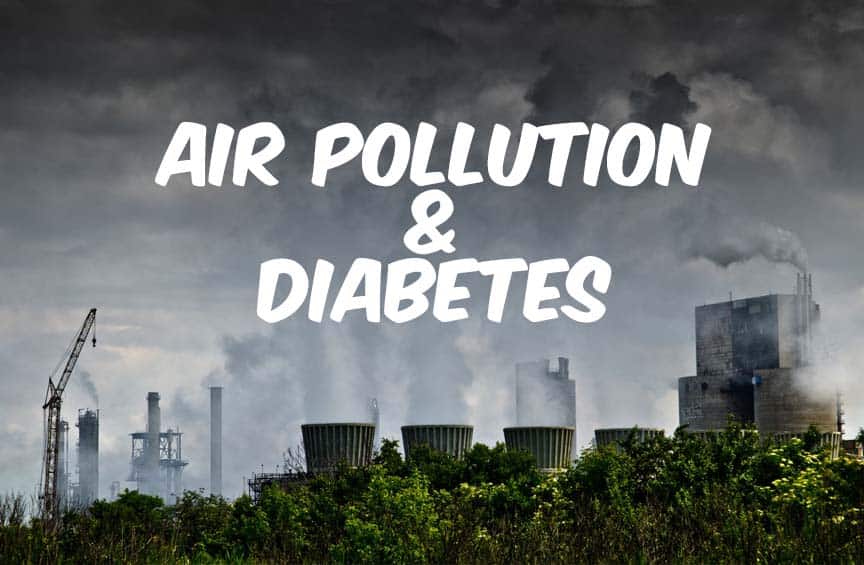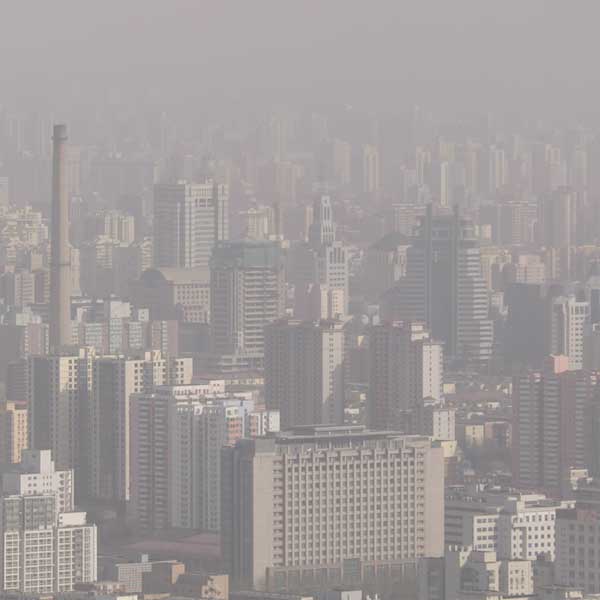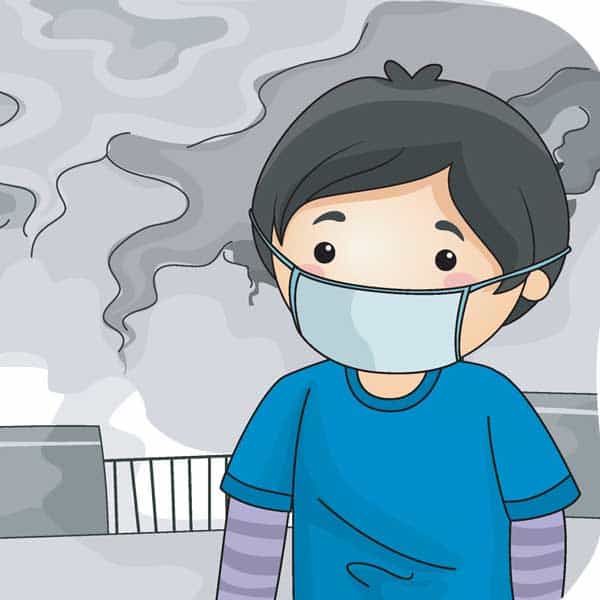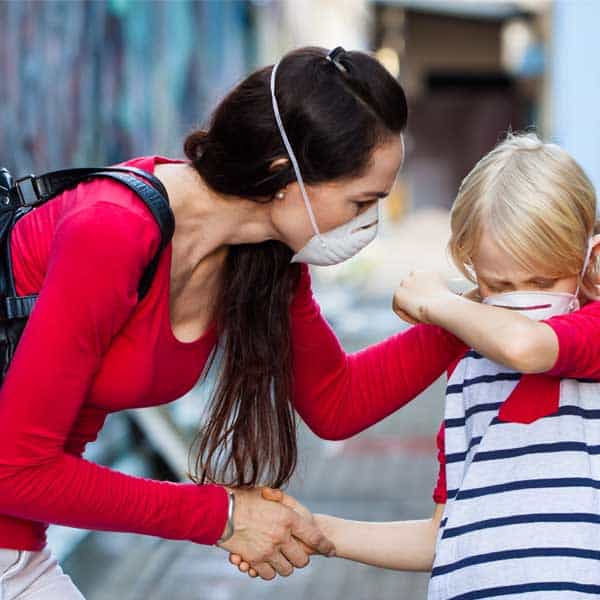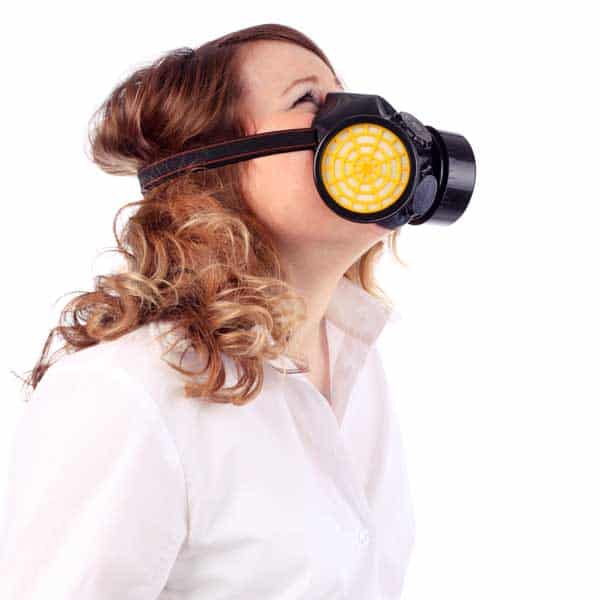We often associate air pollution to car exhaustion that we can see and smell in the distance. But in reality, air pollution exists as a serious constant threat that is odorless and too small to be seen by our naked eyes. At other times, these poisonous pollutants such as artificial fragrances can even smell good and clean from our perception.
What many people do not know is that these harmful chemicals and particles are linked to a wide number of health problems such as allergies, respiratory diseases, cardiovascular diseases, thyroid problems, premature birth, birth defects in babies, cognitive decline, and hypertension. As of 2013, the World Health Organization confirms that air pollution is carcinogenic and can cause various forms of cancers.
But what about diabetes? Can air pollution cause diabetes? This article will discuss this question along with the following topics listed below:
[accordions id="5921"]
Contents
- What Is Classified as Air Pollution?
- Can Air Pollution Cause Type 2 Diabetes?
- Can Air Pollution Trigger Type 1 Diabetes?
- Will Mothers Exposed to Air Pollution Increase Risk of Developing Gestational Diabetes?
- Will Babies Exposed to Air Pollution Develop Diabetes?
- Pesticides and Diabetes
- Can Airborne Contaminants Be a Marker for Risk of Developing Diabetes?
- Can Air Pollutants Increase Chances of Hypoglycemia and Hyperglycemia?
- What is Glycosylation? And How Can It Affect People with Diabetes?
- Is Oxygen the Key to Insulin Resistance, Glycosylation, and Mitochondrial Dysfunction?
- Can Less Oxygen Intake Cause Problems for Diabetes Individuals?
- How Can you Decrease Intake of Air Pollution?
- Ways to Decrease Pollutants At Home
- How to Get Healthy the Smart Way
- Eat Your Way to More Oxygen
- Conclusion
What Is Classified as Air Pollution?
“Air pollution” can be a mixture of man-made artificial and natural matters in the air that we breathe in and which can cause damage to the body. These substances can come in gases or solid particulate matters. Typically, we can classify them as primary and secondary pollutants.
Primary Air Pollutants
They are released in the atmosphere directly from the original source. The most common gaseous air pollutants include:
Sulfur dioxide (SO2) – this gas is one of the biggest problem that affect human health. It is often released from gypsum, commonly used as fertilizer and the main ingredient for making plaster, chalk, and wallboard.
Nitrogen oxides (NOx) – this gas is most commonly released from vehicle exhaust, electric power plants waste products, and burning of natural gas, coal, diesel fuel, and oil. It is also a by-product waste from cigarette smoking, wood burning or gas stove.
Hydrogen sulfide (H2S) – although small amounts can be found in the human body, it is most abundantly found as a waste byproduct at petroleum production plants, sewage treatment plants, waste water treatment facilities, landfills, paper mills, and manure production facilities.
Carbon monoxide (CO) – it is most commonly found in the exhaustion when fuel is being burnt. This includes vehicles, stoves, small engines, fireplaces, grills, gas ranges, furnaces, water heaters, gas dryers, and lanterns.
Ammonia (NH3) – found in most cleaning agents that contains bleach such as window-cleaning products, floor cleaners, toilet and bathtub cleaning agents, laundry detergents, drain and oven cleaners, and shining waxes. It can also be found in many other household items such as pesticides, paint, and hair coloring products.
Carbon dioxide (CO2) – probably the most abundant gas found in the environment. Although all living organisms pass off carbon dioxide, the emission of carbon dioxide comes mostly from gasoline and natural gas burning.
Hydrogen fluoride (HF) – it is produced whenever there is burning of fuels that includes fluoride as part of the ingredient such as coal. It can be found in oil refinery plants, glass and enamel etching shops, and silicon semiconductor chips production plants. It can also be found in some household cleaning agents for removing rust and water spot marks, and cleaning crystals and brassware.
I suggest reading the following articles:
Aside from these harmful gas chemicals, pollutants can also exist as a combination of solid and liquid particles known as particulate matters (also known as PM). The most commonly found mixtures are dust, soot, ash pollen, fume, smoke, mist, spray, radioactive compounds, pesticides, metallic particles, and aerosols. The solid particles in these combinations can vary in sizes from coarse to ultrafine.
Secondary Pollutants
These harmful substances exist as a result of the primary pollutants going through chemical reactions or photochemical reactions in the atmosphere. Some of the common secondary pollutants are ozone (O3), smog, sulfate(SO4), aldehydes, chlorofluorocarbons (CFC), nitrate salts, sulfuric acid (H2SO4), nitrogen dioxide (NO2), and peroxyaceiyl nitrate (PAN).
Where Can These Harmful Compounds Be Found?
We often assume that they can only be found outdoor close to dense traffic or industrial areas. What we ignore are the pollen, pesticides, sewage off-gas, and second-hand smoke that are also hazardous to human. All these gas and particles are known as ambient air pollution (also known as outdoor air pollution). From our increasing scientific knowledge on the extent of health damage as a result of the chemicals, we have found many once considered safe chemicals (e.g. phylates, parabens, and talc) to have numerous important health effects as well. What is worse is that children, infants, and patients with weaker immune system are amongst the utmost vulnerable to many of the air contaminants.
In addition to the direct link between these harmful chemicals and respiratory problems such as asthma attacks, recent studies have found links between air pollution and diabetes, cardiovascular diseases, nerve damages, preterm birth, and even infant mortality.
We often associate the issue as an outdoor problem. But being indoor does not make you isolated from the air pollutants. In essence, any chemicals and particles that are irritating and harmful to the human body is qualified as pollutants.
Some of the most common examples include:
- Gases released from appliances and building material such as carbon monoxide, radon, and ozone
- Household cleaning products, beauty and hair products that includes formaldehyde, bioeffluents, trichloroethylene, ammonia, chloroform, and xylene
- Artificial fragrances that are produced from petroleum and a variety of synthetic chemicals such as acetone, benzene, formaldehyde, alcohols
- Building materials and products that emit off-gas and fumes of formaldehyde, asbestos, fire-retardants, lead, arsenic, gypsum, rubber, plastic, phthalates, bisphenol A, PCBs, dioxins, and perfluorinated compounds
- Airborne allergens from pest droppings and carcasses, pet dander and fur, dust mites droppings, tobacco smoke, mold particles, and pollen from plants
Can Air Pollution Cause Type 2 Diabetes?
Increasing numbers of data indicate that air pollutant exposure is linked to increase risk of developing type 2 diabetes. At the same time, these studies confirm a correlation between the level of air contaminants and the severity of insulin sensitivity in human subjects. What is even more alarming is that the levels of harmful particulate matter in the environment is positively correlated with the levels of blood glucose level of participants who live in effected areas.
These trends suggest that people who live in more polluted areas tend to have a higher level of blood sugar than those who live in less polluted areas. In addition, the much higher frequency of the disease indicates that individuals living in highly polluted areas are much more likely to develop the ailment.
So how does pollution cause the disease is the next question? According to epidemiology evidence, researchers believe that the irritants cause a systemic inflammation reaction in the body. As a result of the problem, the body’s autonomic nervous system and immune system go haywire to compensate for the inflammation. Consequently, this triggers a false sense of “flight or fight” innate immune reaction which increases the cortisol hormone secretion, decrease in glucose metabolism, and increase in weight gain due to imbalanced fat utilization.
All these factors contribute to insulin insensitivity and sends the body into a downward spiral of developing the illness. Along with continuous exposure to the pollutants, the constant stress on the system can permanently damage the liver and the pancreas, thus ultimately causes the onset of type 2 diabetes.
Can Air Pollution Trigger Type 1 Diabetes?
Unlike type 2 diabetes, type 1 diabetes happens when the immune system begins to destroy the beta cells in the pancreas. So in order for an individual to develop the autoimmune disease, they must have the genetic predisposition of the disease and a weakened immune system state to begin the process. Although older research studies have not find any correlation between the poisonous matters and type 1, newer research studies have suggested that it can play a role in the problem. Health studies exhibit that continuous exposure to air pollutants can act as an onset trigger for individuals who have the genetic predisposition requirement. Children who have a family history of diabetes, drug abuse, and autoimmune disease have the highest tendency to develop the disease when they are also in constant contact with ambient ozone and sulfate pollution.
Second hand smoking has also been demonstrated to quicken the onset of type 1 as well. A recent health study performed by Germany exposes that dust particles can surge the risk in children. It seems like what air pollution does in this equation is to disturb the immune system and attack the physical health of the individual to accelerate the onset of the illness.
Will Mothers Exposed to Air Pollution Increase Risk of Developing Gestational Diabetes?
Gestational diabetes mellitus (also known as GDM ) occurs in 14% of all pregnancies in the United States. Although why some women develop the temporary ailment while others do not is still somewhat a mystery to doctors and researchers, they have pinpointed several risk factors that can increase the risk of developing the disease.
Newer researches show that women who are exposed to nitrogen oxide and sulfur dioxide during preconception or the first few weeks of pregnancy during the first trimester can drastically increase the chance of developing gestational diabetes. It has also been shown that exposure to ozone later in pregnancy can also increase the chance of developing GDM as well as type 2 later in life. In addition, based on what we observe in how these toxins can cause the disease, there has been suggest that perhaps these poisonous chemicals can cause inflammation reaction and hormone imbalance in pregnant women as well.
Will Babies Exposed to Air Pollution Develop Diabetes?
Obviously, this question goes hand in hand with pregnant mothers being exposed to airborne pollutants. Although very little is known on this topic, what we do know is that it increases the chance of low birth weight in babies whose mothers are exposed to air pollution. Other symptoms observed are jaundice, early birth, later learning and behavioral problems (e.g. ADHA, bipolar disorder, and autism), birth defects, and even sudden infant death syndrome (SIDS). In addition, if the mother develops GDM during pregnancy, the baby is more likely to develop type 2 diabetes as well. Researchers found that exposure to second-hand smoking in the household can drastically accelerate the onset of type 1 in babies and infants who have the predisposition prerequisites.
More importantly, poor air quality is a catalyst for developing health problems in young children such as obesity, asthma, cardiovascular problems, and diabetes. Clinical health reports indicates that children who live in highly polluted areas on average have 13% less efficient pancreatic beta cells than others who live in less polluted areas. So for those who already have the family history of having the illness and/or other health problems, poor air quality can truly create a lot of damage to these children.
Pesticides and Diabetes
Pesticides and Type 2 Diabetes
What is alarming is that recent reports exhibit a link between the disease and pesticide exposure. In a United States army study, the soldiers who are frequently exposed to dioxin from Agent Orange have a much higher rate of developing the problem than other soldiers who are not exposed to the chemical. Similarly, recent population studies have shown that individuals who are often exposed to polychlorinated biphenyls and chlorinated pesticides are the ones most likely to develop the illness. What is interesting in this study is that these individuals who have develop the disease are often found to have healthy weight and are not obese by medical standards. Although health researchers are still investigating how pesticides can cause the disease, this finding suggests that these harmful chemical can perhaps alter the insulin action and render it inefficient for glucose metabolism.
Pesticides and Type 1 Diabetes
A current health study on Egyptian children have found that many new type 1 patients tend to have a higher level of the malathion pesticide in their blood samples than individuals do not have malathion. It is important to also note that even though pesticides are air pollutants, they are also food contaminations.
Scientists have demonstrated in animal studies that repeated ingestions of various pesticides can induce intestinal inflammation, reduce the gut microbiota diversity, and produce abnormal intestinal absorptivity – all common symptoms found in individuals with type 1 diabetes. Moreover, certain pesticides such as organophosphate have found to be poisonous to the immune system and cause inflammation reaction that throws off the immune responses. These results suggest that perhaps pesticides may play a role in the development of type 1 in young children who are at the highest risk as they have quicker metabolism rate than adults.
Pesticides and Gestational Diabetes
A correlation studies have found that women who are in constant contact with pesticides and herbicides during the first trimester of pregnancy have the highest tendency to develop gestational diabetes. Of all the agricultural chemicals, diazinon, carbofuran, and phorate insecticides; and butylate, atrazine, 2,4,5-T, and 2,4,5-TP herbicides are found to have the most impact on the disease development.
Can Airborne Contaminants Be a Marker for Risk of Developing Diabetes?
Although there is no strong evidence that air pollution can directly increase chance of developing type 1, it has shown to be a marker of type 2 risk because pollutant is directly linked to insulin resistance. Both clinical studies and correlation studies have found that exposure to air impurities can escalate insulin resistance, an indicator of the risk. This influence is most prevalent in people who are already identified as prediabetic due to high blood sugar levels. And of all the pollutants, nitrogen dioxide exhibit the most effect on glucose intolerance.
Correlation studies have found that for every 7.9 microgram per cubic meter increase in particulate matter, there is a 15% higher rate of glucose intolerance. For those prediabetes individuals, the danger is increased by almost 46% for each unit increase in air pollution. Even though these correlation findings cannot explain how exactly these harmful chemicals cause insulin intolerance, researchers believe that the toxic chemicals produces a body-wide general inflammation, surges the levels of oxidative stress, and produces an autonomic imbalance reaction. To compensate for the condition, the body signals an elevated level of cortisol secretion, and ultimately disturbs how blood glucose and fat are being metabolize in the body. Hence, for people who are already suffering from poor glucose metabolism, the airborne toxins can multiply the problem exponentially and increases the chance of these individuals developing type 2 diabetes.
Can Air Pollutants Increase Chances of Hypoglycemia and Hyperglycemia?
The answer is yes. Because it directly affects insulin insensitivity, it can definitely increase the chances of developing hyperglycemia and hypoglycemia episodes. What we also know is that it has a tendency to cause a general inflammation state in the body and triggers excessive amount of cortisol hormone secretion. As insulin deficiency is more known to cause hyperglycemia, it is more likely that the harmful chemicals and particulate matters will cause hyperglycemia than hypoglycemia. On the other hand, the cortisol secretion, physical stress, and adrenal fatigue can lead to episodes of hypoglycemia. So depending on the person’s physical health and exposure to the pollutants, the symptoms can vary from person to person.
The most important thing to note is that because of the problem, people can find it exceptionally difficult to control their blood sugar level, manage their symptoms, and lose weight.
What is Glycosylation? And How Can It Affect People with Diabetes?
To put it simply, glycosylation is a chemical reaction that occurs when glucose molecules in the blood attach to protein molecules. It can happen without any enzyme. The problem for these reactions is that it renders the glucose to be less effective at producing energy for the body. At the same time, it is very dangerous because it causes inflammation to the body and clogs up the body with the bind proteins. A quick symptom may be a general sense of fatigue experienced by the patients.
Nevertheless, over the time, repeated episodes of glycosylation reactions can lead to nerve damage, kidney damage, liver problems, eye lenses damage, clogged blood vessels, and cardiovascular diseases. For people with the ailment, this is an even more complicated problem during hyperglycemia episodes when glucose becomes overly abundant in the bloodstream and ready to bind with proteins. This is a reason why these individuals are at risk of so many health complications. And because of the airborne problem effects on the body, these complications can accelerate at an alarming rate.
Can This Be a Reason Why Diabetes Patients Cannot Lose Weight?
There is a common misconception that diabetes individuals are overweight because they do not exercise and pay attention to their food intake. What the general public do not know is that certain toxin chemicals known as “obesogens” that can exacerbate weight gain by altering the functioning of endocrine system responsible for metabolism, energy balance, and appetite. These special matters tend to affect the metabolism of brown adipose tissues (BAT) that are responsible for producing energy, controlling fat metabolism, and maintaining the body weight.
Scientific researches have found that glucose and lipid metabolism are largely dependent on mitochondria in the BAT to generate energy in cells. So when the mitochondria organelles become ineffective, it can lead to insulin resistance. In addition, it has been proven that cigarette smoking as well as second hand smokes lead to decrease in mitochondria size as well as lowering the efficiency of energy production and maintaining the usual body weight. These evidence suggest that airborne chemicals can have a similar effect on the BAT mitochondria functioning and difficulty in losing weight.
Besides the brown adipose tissues findings, scientific observations indicate that type 2 individuals who live in higher PM (particulate matters) level areas tend to have lower levels of adiponectin, a protein that is responsible for regulating blood glucose levels and breakdown of lipids in insulin-sensitive tissues. Investigators found that decreased amount of adiponectin in the blood contributes to human obesity as well as increased in insulin resistance. On average, type 2 individuals have a significantly lower level of adiponectin. Therefore, in the presence of poor air quality, the even lower amount of adiponectin protein can be the main reason why patients with diabetes have a harder time losing weight.
Is Oxygen the Key to Insulin Resistance, Glycosylation, and Mitochondrial Dysfunction?
Oxygen is a necessity to life, but it is also vital to many functioning in the cells of the body. One of the most important role for oxygen is to maintain the functioning of the mitochondrial functioning and stimulating the metabolism rate in the body. That means if there is not enough oxygen intake for the body, the brown adipose tissue will be less efficient in utilizing glucose and fat. Consequently, the body will react to the stress by increasing insulin resistance and weight gain.
Another issue with oxygen is that it is responsible for cell rejuvenation and boosting the immune system. Studies have shown in animal studies that subjects are faced with severe level of inflammation when less oxygen is supplied to the fat cells. This reaction puts the liver and the body in a stressed mode so that more cortisol is secreted into the body to prevent proper utilization of insulin. Over the time, this continuous stress can severe damage the liver to create mitochondrial and glycosylation dysfunction, thus making even healthy individuals much susceptible of developing the syndrome.
Can Less Oxygen Intake Cause Problems for Diabetes Individuals?
In order to answer this question, we must first understand how oxygen can affect a healthy individual. Research studies on the link between restricted oxygen intake and insulin resistance in healthy mountain climbing individuals. It has been found that as participants reach higher altitudes and suffer from less oxygen intake, they develop a temporary insulin resistance condition. However, when they reach back to an elevation that allows regular oxygen intake, this condition gradually dissipate. For individuals with the syndrome, less oxygen intake can severely exacerbate the insulin resistance problem.
Another clinical studies have observe the how better air quality with higher oxygen level can help with the complication. By giving 6 sessions of hyperbaric oxygen therapies (a technique usually given to patients to treat elevation sickness) to type 2 patients over a course of 5-week duration, researchers have witness a significant 40% improvement in insulin resistance and a 13% body weight loss in these individuals. From these two studies, we can deduct that the more oxygen we receive, the better our bodies are at utilizing glucose and burning fat. It also explain why deprived air quality can be such a detrimental problem for both type 1 and type 2 individuals. For those who also suffer from various health complications (e.g. sleep apnea and cardiovascular diseases) that further restrict oxygen intake, unhealthy air quality can truly deteriorate the body condition.
How Can you Decrease Intake of Air Pollution?
These days, you may come across some people walking on the street with a surgical mask on trying to avoid inhalation of the car exhaustion and other harmful chemicals in the air. The truth is that these masks have very limited benefits. In 2012, a research study done in Beijing found that a common handkerchief will let 72% of pollutant pass through the fabric. The cycling masks surgical masks can still allow 16 to 46% of pollutants through depending on the quality. Although slightly more effective, surgical masks can still let 20% of the particles pass through. Even the 3M heavy duty industrial use mask will still allow small amount of matter pass through. Although they can make a difference during the smoggiest days, what other ways can you decrease your intake of these harmful substances?
Here are some tips that may help:
- Always check the Air Quality Index (AQI) before leaving your home.
- Avoid traveling outdoor during the busy hours. This can really cut down the inhalation of traffic-related pollutants and irritants.
- Avoid traveling during the hottest time of the day. Plants tend to release the most pollen during warmer temperature. Although less harmless than chemicals, pollen is still an irritant and can still be trapped in your air passages to cause breathing problems.
- Try to stay away from the edge of a pavement. Health studies conclude hat walking along the pedestrian pavement edge can expose you to 1/10th more pollution than walking closer to the building side. And when you are waiting for the traffic light to change, step back as much as possible because the car exhaustion is at its peak at the red lights. If you have any young children with you, it is a wise choice to pick them up during the wait because they are often at a height closest to the exhaustion pipes.
- Children suffer more damage than adults because they have a quicker metabolic rate, lower tolerance to irritants, and breathe more rapidly. So when you walk them to school, try to pick a route that is away from the busiest traffic.
- Always trust your nose. If you smell something funny that make you feel uncomfortable, you are likely to be inhaling something toxic. Move away from the source immediately. If you cannot, cover your nose with the back of your sleeve or with a handkerchief.
- Do not stand near a photocopy machine or laser printer. These office machines are constantly expelling ozone gas. If you can smell it at your office desk, you are sitting too close to it.
- Eat food that will help you pass out the toxin and undo the damage. For example, blueberries can help alleviate signs of inflammation to the body. Vitamin C rich foods are great antioxidants that will help you detox your body from all the toxins. Other helpful foods are dark green vegetables, papaya, purple-color vegetables and fruits, and green tea.
- Drink plenty of water so that your body can pass out the toxins more easily.
Ways to Decrease Pollutants At Home
Even when you are at home, you can still be exposed to many pollutant sources. These can be particles you bring in on the way from home.
To make sure you and your family members can enjoy cleaner air at home, here are some tips that may help:
- Test your home for radon gas leeching into your home from the foundation or various building materials. Invisible and odorless, this radioactive gas can significant increase your chance of developing breathing problems, reducing your oxygen intake, and getting lung cancer.
- All smoke (whether it is fireplace smoke, cooking fires, stovetop fume, or second-hand smoke) are toxic and carcinogenic. Make sure your home is well ventilated when you cook or lit up a fire. If you are a smoker, smoke outside to prevent accumulation of fume inside your home. If you use your fireplace frequently, make sure to clean and maintain the chimney and flue regularly to minimize soot and ash.
- Install alarms to detect smoke and carbon monoxide. However, be careful that sometimes these alarms can only detect heavy doses of gas leakage. Your defective furnace and heating devices can have a small leak that affect your health over a duration of time. It is best to check and inspect these devices regularly.
- Certain products in your home are known to release toxic gases. Some common products are paints, paint removers, varnishes, cleaning products such as bleach, glue, and adhesive materials. Try to keep these in the garage or your garden shed.
- Keep your office equipment such as printers and copiers out of your bedroom. They emit ozone that will cause breathing problems and exacerbate asthma conditions.
- Instead of using store-bought heavy duty leaning products, look for more environmental-friendly cleaners such as vinegar, baking soda, and citric acid powder. These 3 chemicals can clean a lot of tough stains if you know the right way of cleaning. There are also many homemade cleaning agent recipe you can find online. One of the greatest natural recipe is orange peel vinegar solution. It will clean your dirty oven within minutes and leave a great citrus smell in the air.
- Asbestos in building materials are carcinogenic and can cause a lot of breathing complications. Houses that are built before 1975 are known to contain asbestos. To find out whether you suffer from asbestos problem, call a professional company about the testing and removal of the materials. Do not attempt to remove them yourself without all the proper gear and safety regulations.
- If your home is built before 1978, you may want to test if your wall contains lead paint which can damage the nervous system and kidneys, and it is deadly to young children who put their fingers everywhere. You can do the testing yourself by purchasing a testing kit at home hardware stores.
- Invest in a vacuum cleaner with HEPA filter to suck up all allergens before they become airborne in your home. Although they are slightly more expensive, they work much more effectively getting rid of pollen, dust mites, dust, ashes and soot, pet dander, and brominated fire-retardant chemicals.
- Swipe your floor often. If you can never manage to swipe off everything off your floor, you can try throwing your used loose tea leaves on the floor. The damp tea leaves are great at clinging onto all the small particles on the floor and make the task much quicker and easier. To finish off, mop up the extra moisture with a microfiber mop. The tea leaves can act as a natural air freshener.
- Clean out your vacuum canister immediately after use. Although all that dust and debris are contained in the bag, they can still emit smell and slowly leech back into your living space.
- You do not need all the artificial freshener to make your laundry smell nice. Although many people associate these “fresh linen smell” as a clean home, it actually makes your home full of air pollutants. Opt for fragrance-free detergents and dryer sheets. If you would love your laundry to smell great, you can sprite of lemon juice to do the trick. And if you truly love fragrances, opt for all-natural concentrated oil and add it into your dryer balls instead.
- Same goes for your home. Stop using aerosol air freshener sprays as they contain the worst chemicals. Most of these artificial fragrances are derived from petroleum products and can actually cause breathing problems along with skin irritation. If you wish to have a great smelling home, you may consider planting some indoor fragrance plants. Not only will they make your home smell great, they can also act as a multi-tasking air purifier. It will increase fresh oxygen in the home while the roots absorb the chemical pollutants in your home. It is recommended to have 2 plants per 100 square feet in a home that has an 8 to 10 feet ceiling to maximize the filtering effect. Some of the great plant choices that do not spread pollens are Bamboo, Chinese Evergreen, Spider Plant, Aloe Vera, palm, English Ivy, Arrowhead Plant, Peace, Umbrella Plant, Mum, Lily Madagascar Dragon Tree, Cacti, Devil’s Ivy, Heart-Leaf Philodendron, Warneckie Snake Plant, Split-Leaf Philodendron, Corn Plant, and Ficus.
- To deal with odor problems, there are many environmental friendly solutions. Tea bags can soak up stinky shoe smells and gym ball smells. Baking soda packets are great for absorbing odor in the refrigerator, bathrooms, and carpets. A great option for odor problem is bamboo charcoal. Known for antibiotic properties, bamboo charcoal can not only absorb the odor but also kill off the mold spores and germs in your home. What is awesome about it is that it is not poisonous and can actually be ingested as a form of toxin absorber. For homes with young children and pets, this is a great option to consider. Moso Natural Air Purifying Bag is a wonderful choice that can be used in your closet, bathroom, and even your car.
- Invest in a HEPA air filter in your bedroom. It will drastically improve the air quality and remove all airborne irritants that can affect your breathing when you sleep.
- Make sure that your home is maintained at a healthy level of humidity (usually between 30 to 50%) because moisture is the breeding ground for mold and dust mites. During the summer months, do not overwater plants and make sure your bathroom is properly dried and ventilated. Make sure that there is not water trapped in your air conditioner because mold can grow inside and be spread everywhere by the air current.
- Only open your windows if your home is not close to busy traffic. If you like to have an incoming source of fresh air, it is wise to install a HEPA air filter system to sift out all the pollutants before the air enters your home.
How to Get Healthy the Smart Way
We all know that cardio exercise is great for our health. And as mentioned earlier, the more oxygen you can bring into the body, the better your body can fight off insulin resistance and weight gain. So how can we increase the oxygen flowing into our bodies? One obvious answer is to increase our breathing rate through cardio exercise. It not only helps bringing large volumes of oxygen into the body, but also increase blood circulation to allow oxygen to be carried all over the body for use.
Of all the cardiovascular exercises, researchers have found high intensity interval training to be the most successful for improving insulin resistance and glucose metabolism. In a clinical study conducted at Queen’s University of Ontario, Canada, participants who have engaged in regular high intensity interval training exercises have shown a 9% improvement in insulin resistance than those who have engaged in regular low intensity cardio exercise over a six-month study. They also benefit from a significantly lower blood lipids, decrease in body fat, and improved cardiovascular fitness at the end of that 6 months duration.
We know that any form of cardio exercise are beneficial to your health. The problem is if you try to exercise in a heavily polluted area, you may actually cause more harm than good to your body condition.
Here are some tips to help you get the most benefits out of your exercise:
- Do not exercise in an area close to busy traffic or near the parking lot. If you enjoy doing exercise in the outdoor, pick a spot that has cleaner air source.
- Exercise early in the morning or later evening when both pollution level and pollen count is lower.
- Consider trying using allergen block gel to minimize pollutant particle intake. These gel works by blocking particles on contact before they are able to enter your nose. Check out Chloraseptic Allergen Block Gel.
- If you enjoy exercising indoors, running a HEPA air filter machine while you workout can maximize your oxygen intake.
Eat Your Way to More Oxygen
Exercising is not the only way you can increase your oxygen intake. Did you know that organically grown vegetables, fruits, whole grains, nuts, and seeds have a much higher oxygen content than the chemically fertilized choices? By eating healthier choices of foods, you can immediately receive an increase of oxygen into your body. Similarly, drinking mineral water can help you increase your oxygen intake as well as a great source to detox your body from all the toxins. You may also consider using supplemental liquid oxygen drops to your drinks to maximize intake.
Technology Gadgets against Airborne Toxins
Breathing in higher quality air can truly benefit your health. Here are some technology tools that can help you minimize breathing in pollutants from your environment.

- Awair Air Quality Monitor is the best seller on Amazon for several reasons. It is not only stylish, but it is easy to use and it can be synced up to your smart devices through wifi and Bluetooth.

- CleanSpace Tag Personal Air Pollution Smart Sensor by Freevolt is a great choice as it is extremely lightweight and easy to use.

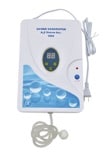
- We recommend A2Z Ozone Aqua 6 Multi Purpose Ozone Generator.
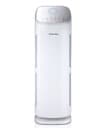
- Conway Tower Mighty Air Purifier with True HEPA is recommended.

- The GermGuardian is a small yet powerful UV-C air sanitizer and odor eliminator that is great for bathrooms and smaller enclosed space.
For bigger high traffic spaces in your home, you may need a more heavy duty sanitizer to match your needs.
The GermGuardian AC-4825 3-in-1 Air Cleaning System is a highly recommended choice. With UV-C light sanitizer technology, True HEPA filter, and odor eliminating charcoal filter, this system is guaranteed to remove 99.97% of all airborne pollutants, kill off germs and mold spores, and eliminate odor from your home at the same time.

- For this checkout WoodyKnows Gas and Pollutant Reducing Nasal Filters.
Further reading:
Conclusion
We hope that this article may answer most of your questions and concerns on how air pollution can affect diabetes. If you have any comments, tips, and/or personal experience you wish share with our community, please leave us a message. We would be thrilled to hear from you.
TheDiabetesCouncil Article | Reviewed by Dr. Christine Traxler MD on May 23, 2020
References
- Carpenter DO. Environmental contaminants as risk factors for developing diabetes. Rev Environ Health 2008;23:59–74.
- Ceriello A, Bortolotti N, Motz E, et al. Meal-generated oxidative stress in type 2 diabetic patients. Diabetes Care 1998 Sep;21(9):1529-33.
- Chandran, Manju, et. al. Adiponectin: More than just another fat cell hormone? Diabetes Care, 2003; 26(8): 2442-2450.
- El-Morsi, Doaa, et. al. Pesticides residues in Egyptian diabetic children: A preliminary study. Clinical Toxicology 2012, 2:6.
- Eze, Ikenna C., et. al. Air pollution and diabetes association: Modification by type 2 diabetes genetic risk score. Environment International 2016; 94: 263-271.
- Goldberg MS, Burnett RT, Yale JF, Valois MF, Brook JR. Associations between ambient air pollution and daily mortality among persons with diabetes and cardiovascular disease. Environ Res 2006;100:255–267.
- H. Franklin Bunn, K. H. Gabbay, P. M. Gallop. The Glycosylation of Hemoglobin: Relevance to Diabetes Mellitus. Science, Vol 200 7 April 1978 p21-27.
- Jerrett, M. et al. Ambient ozone and incident diabetes: A prospective analysis in a large cohort of African American women. (2016) Environ Int. 30.
- J.R. Perry, T.M. Frayling. New gene variants alter type 2 diabetes risk predominantly through reduced beta-cell function. Curr. Opin. Clin. Nutr. Metab. Care, 11 (2008), pp. 371–377.
- J. Schwartz, S.K. Park, M.S. O'Neill, P.S. Vokonas, D. Sparrow, S. Weiss, et al. Glutathione-S-transferase M1, obesity, statins, and autonomic effects of particles: gene-by-drug-by-environment interaction. Am. J. Respir. Crit. Care Med., 172 (2005), pp. 1529–1533.
- Kathrin Wolf, Anita Popp, Alexandra Schneider, Susanne Breitner, Regina Hampel, Wolfgang Rathmann, Christian Herder, Michael Roden, Wolfgang Koenig, Christa Meisinger, Annette Peters. Association Between Long-Term Exposure to Air Pollution and Biomarkers Related to Insulin Resistance, Subclinical Inflammation and Adipokines. Diabetes, 2016
- Mays, CA. et al. Assessment of the link between in utero exposure to 2-aminoanthracene (2AA) and type-1 diabetes (T1D).
- Kathrin Wolf, Anita Popp, Alexandra Schneider, Susanne Breitner, Regina Hampel, Wolfgang Rathmann, Christian Herder, Michael Roden, Wolfgang Koenig, Christa Meisinger, Annette Peters. Association Between Long-Term Exposure to Air Pollution and Biomarkers Related to Insulin Resistance, Subclinical Inflammation and Adipokines. Diabetes, 2016.
- O’Neill MS, Veves A, Zanobetti A, et al. Diabetes enhances vulnerability to particulate air pollution-associated impairment in vascular reactivity and endothelial function. Circulation 2005;111:2913–2920.
- O’Neill MS, Veves A, Sarnat JA, et al. Air pollution and inflammation in type 2 diabetes: a mechanism for susceptibility. Occup Environ Med 2007;64:373–379.
- Rao et al., X. Rao, J. Montresor-Lopez, R. Puett, S. Rajagopalan, R.D. Brook. Ambient air pollution: an emerging risk factor for diabetes mellitus Curr. Diabetes Rep., 15 (2015), p. 603.
- R.E. Vella, N.J. Pillon, B. Zarrouki, M.L. Croze, L. Koppe, M. Guichardant, et al. Ozone exposure triggers insulin resistance through muscle c-Jun N-terminal kinase activation. Diabetes, 64 (2015), pp. 1011–1024.
- Rignell-Hydbom A, Lidfeldt J, Kiviranta H, et al. Exposure to p,p’-DDE: a risk factor for type 2 diabetes. PLoS ONE 2009;4:e7503
- Robledo, C.A. et al. Preconception and early pregnancy air pollution exposures and risk of gestational diabetes mellitus. Envion Res, 2015 Feb; 137: 316-322.
- Saldana, T.M., et. al. Pesticide exposure and self-reported gestational diabetes mellitus in the Agricutlural Health Study. Diabetes Care, 2007 Mar; 30(3): 529-534.
- S.K. Park, S.D. Adar, M.S. O'Neill, A.H. Auchincloss, A. Szpiro, A.G. Bertoni, et al. Long-term exposure to air pollution and type 2 diabetes mellitus in a multiethnic cohort. Am. J. Epidemiol., 181 (2015), pp. 327–336.
- S. Singh, Y.S. Prakash, A. Linneberg, A. Agrawal. Insulin and the lung: connecting asthma and metabolic syndrome. J. Allergy, 627384 (2013), p. 2013.
- Toyokuni S. Reactive oxygen species-induced molecular damage and its application in pathology. Pathol Int 1999 Feb;49(2):91-102.
- Wolff SP, Jiang ZY, Hunt JV. Protein glycation and oxidative stress in diabetes mellitus and ageing. Free Radic Biol Med 1991;10(5):339-52.
- Zanobetti A, Schwartz J. Cardiovascular damage by airborne particles: are diabetics more susceptible? Epidemiology 2002;13:588–59


